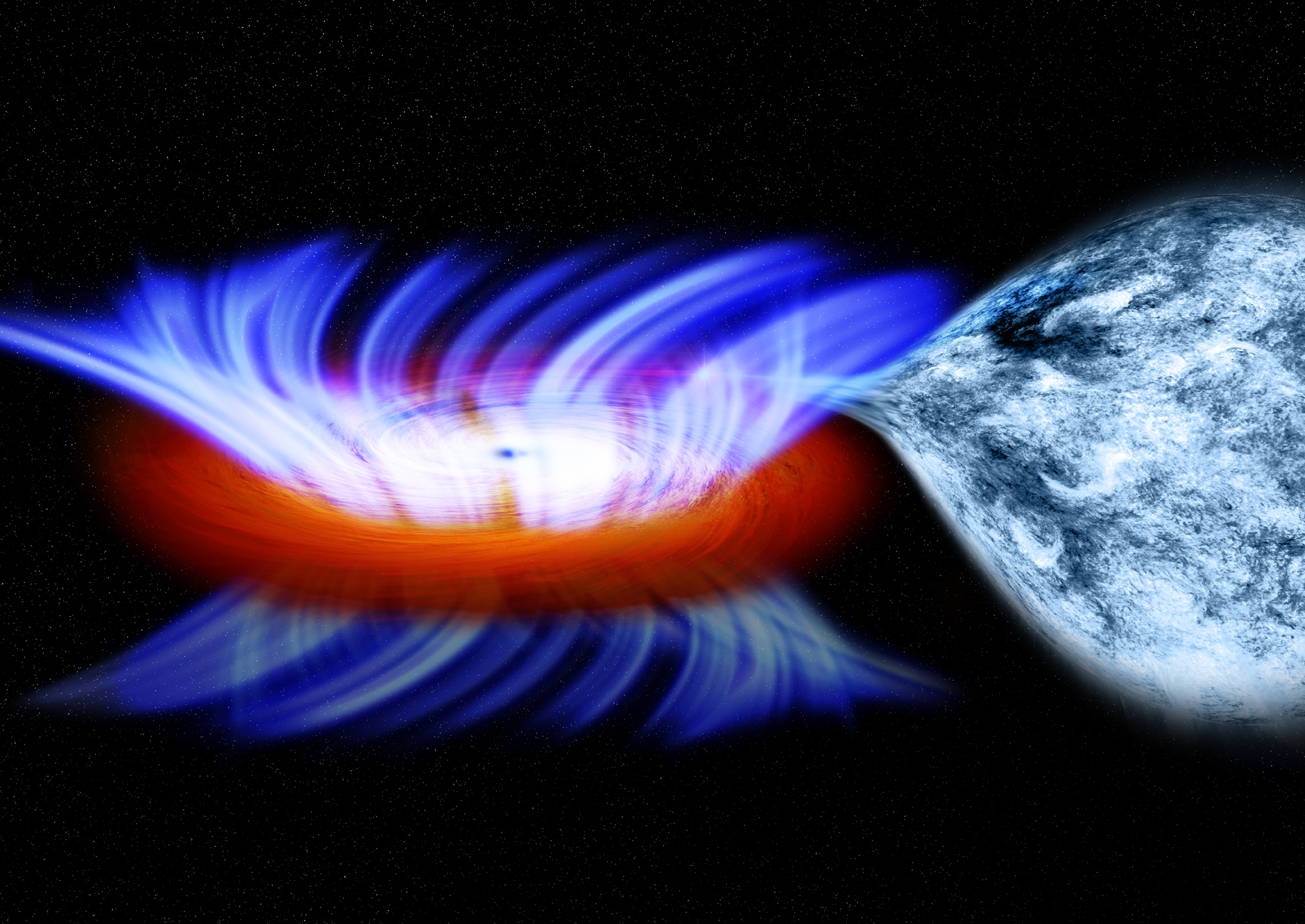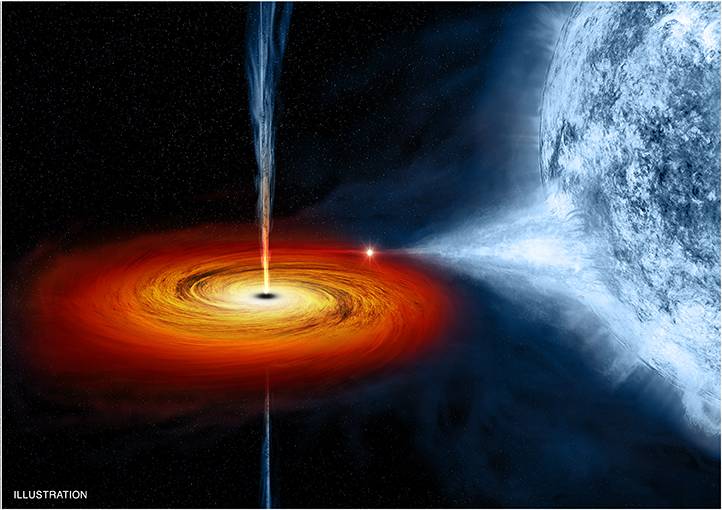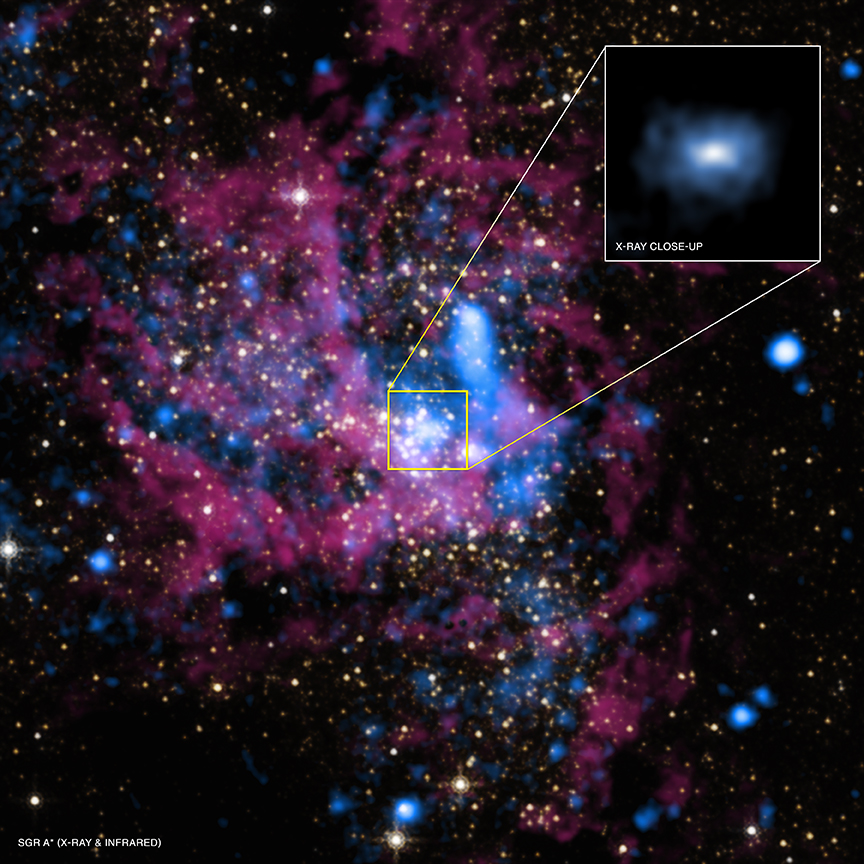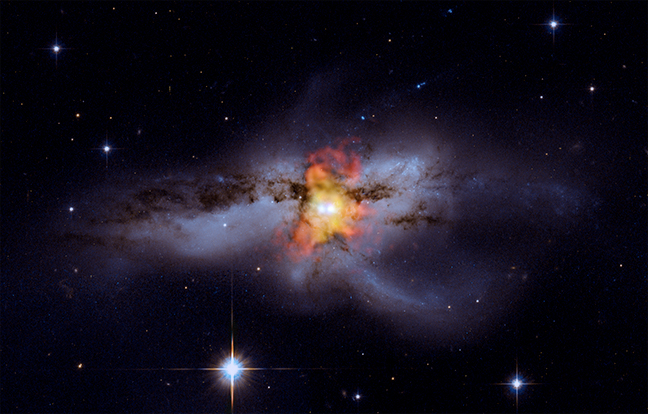Black holes: scandals, intrigues, investigations
Taking this opportunity, we want to thank all readers of our blog for their support and healthy criticism of our articles on space. Let me continue this topic with a small selection of materials on the most, perhaps, popular form of celestial bodies after stars and planets: on black holes. Despite the fact that, in general, very little is still known about these interesting objects, they can be called “mysterious” with a great stretch.
The term black hole refers to objects, the gravity on the border and inside of which is so great that even photons cannot leave this object. In other words, even the light is not able to escape beyond the limits of black holes, hence the tragic and poetic name. The boundary, after crossing which it is no longer possible to leave the limits of the black hole, is called the event horizon . No less poetic, is it? Strictly speaking, black holes do not have a surface or some other real boundary. What happens to the substance inside the event horizon is unknown to anyone, so it can be considered as a “surface” conditionally.

')
Modern science believes that there are three types of black holes:
Some time ago, they also talked about "medium" BH, but their existence is the subject of heated debate: in particular, no satisfactory explanation of the mechanism of their formation was found. In this article we will focus on the "ordinary" and supermassive black holes, the existence of which is considered to be fully confirmed.
Formally, black holes themselves are completely invisible (just because even the light cannot leave their limits). However, thanks to the giant gravitational attraction, black holes are surrounded by an accretion disk consisting of interstellar gases, dust, and other objects that have happened alongside.
In the process of falling, the accumulated matter of which the disk consists spins around the BH in a spiral, gains tremendous speed and warms up, as a result of which the accretion disk radiates in the ultraviolet and x-ray spectrum. This radiation makes it possible to detect black holes in the depths of space.
In the minds of many people, black holes are the mysterious and all-consuming embodiment of the infernal abyss. But not all matter revolving around a black hole is absorbed by it. Part of the matter of the accretion disk is emitted in the form of the cosmic wind as a result of intense heating and high rotational speeds. For example, in 2011, it was discovered that the black hole of stellar mass IGR J17091-3624 periodically emits the fastest of similar “winds” known today: its speed reaches about 30 million km / h, which is 3% of the speed of light.
In addition, black holes also have the property of emitting matter in the form of narrowly directed plasma emissions directed from both “poles” perpendicular to the plane of rotation of the accretion disk. This one looks like an axis on which a disk is mounted. These ejections are called jets [eng. jet ], or relativistic jets . The mechanism of their formation is still not well understood. In supermassive black holes, the jet power is such that it can stop the flow of interstellar gas to the center of the galactic cluster. The jet ejection velocity is several times higher than the “wind” velocity.

Statistically, the black holes of stellar masses should be the most common type in the universe. In fact, this is one of the forms of the posthumous existence of cooled stars. However, not every star after its death turns into an endless absorber of all things. Theoretical calculations predict that only if a star has a mass of at least 3-6 times more solar, then it has a chance to become the benchmark of the Absorbent.
The mechanism of the rebirth of a star into a black hole proceeds, according to scientists, according to the following scenario. Two differently directed forces act on matter inside the star: compression (gravity) and expansion (thermonuclear reactions). In fact, for the time being, any star is in a state of precarious equilibrium, in which gravitational compression is compensated for by constant thermonuclear “seething”. However, over time, the concentration of substances that serve as fuel for thermonuclear fusion in the core of the star decreases. The balance of forces is disturbed, and the nucleus begins to rapidly contract and condense. The outer layer, "burnt out", also begins to shrink, actually falling on the core. Here the story can go in different ways - it depends, in particular, on the mass of the star. One of these ways is the explosion of a star as a result of the shell falling on the core and turning into a supernova. With the explosion, the star finally shrinks to a diameter of 20-30 km, while acquiring colossal density. The resulting object has such a strong gravitational field that space-time is curved near the event horizon. This should manifest itself, for example, in the curvature of light rays.
According to the Schwarzschild solution of the Birkhoff theorem , the radius of aspherical horse in a vacuum of the event horizon of a spherical black star is determined by the formula:
R = 2GM / c 2 , where G is the gravitational constant, M is the mass of the star, and c is the speed of light.
Thus, in order for our Sun to turn into a black hole, it must be compressed to 6 km in diameter (instead of 1,392,000 km). As you understand, such a newborn black star has an incredible density. However, with increasing mass, the density decreases, and this dependence is nonlinear. If the “ordinary” black star is compressed to the “core to core” state, then supermassive black holes weighing 10 5 -10 10 , which are the cores of galactic clusters, have a density comparable to the most common substances known to us. For example, a BH with a mass of 1 billion solar (and this is not a record holder in heavy weight!) Will have a density of about 18.5 kg / m 3 , which is only 10 times the density of air.
Sagittarius A * (Sagittarius A *) , located 26,000 light-years from us. Supposedly, it is this supermassive black hole that is the center of our Milky Way galaxy. Mass - about 4 million solar. The density is about 100 times higher than the density of lead.

M84 , a massive galaxy in the constellation Virgo, located 55 million light years from us. Here you can see an example of the work of supermassive black hole jets.

NGC 6240 , a binary system of supermassive black holes that are in the process of merging. So far there are no solid hypotheses, what happens in such cases, unlike, say, the process of collision between a star and a supermassive black hole . It is believed that it is during the confluence of massive black holes that the strongest gravitational waves arise in the universe.

What does a black hole look like? Logic dictates that when an object falls, a certain moment disappears beyond the darkness of the event horizon. However, it is not. When approaching the event horizon, the object will stretch in the radial direction and contract in the transverse direction. Reaching the point of no return, the object is extremely elongated, slow and harden. This is due to the fact that no radiation, including in the optical range, can escape beyond the horizon of events. For the body itself, the fall will never fall subjectively due to the endless slowdown of time.
A recent study by Stephen Hawking suggests thatnothing lasts forever under the Moon from the point of view of quantum physics, black holes still lose energy by themselves, and not only due to collisions of their accretion disks. This hypothetical effect is called Hawking radiation . If the theory is correct, then, in the absence of feeding with matter, over time, the black hole should lose energy faster and eventually explode. However, quantum theory as a whole has been worked out so superficially that Hawking's theory basically creates more questions than assumptions.
The term black hole refers to objects, the gravity on the border and inside of which is so great that even photons cannot leave this object. In other words, even the light is not able to escape beyond the limits of black holes, hence the tragic and poetic name. The boundary, after crossing which it is no longer possible to leave the limits of the black hole, is called the event horizon . No less poetic, is it? Strictly speaking, black holes do not have a surface or some other real boundary. What happens to the substance inside the event horizon is unknown to anyone, so it can be considered as a “surface” conditionally.

')
Modern science believes that there are three types of black holes:
- Microscopic - quantum - BH
- Supermassive BH (10 5 -10 10 solar masses), which are the cores of most galaxies
- BH stellar mass (3-100 solar masses)
Some time ago, they also talked about "medium" BH, but their existence is the subject of heated debate: in particular, no satisfactory explanation of the mechanism of their formation was found. In this article we will focus on the "ordinary" and supermassive black holes, the existence of which is considered to be fully confirmed.
Formally, black holes themselves are completely invisible (just because even the light cannot leave their limits). However, thanks to the giant gravitational attraction, black holes are surrounded by an accretion disk consisting of interstellar gases, dust, and other objects that have happened alongside.
In the process of falling, the accumulated matter of which the disk consists spins around the BH in a spiral, gains tremendous speed and warms up, as a result of which the accretion disk radiates in the ultraviolet and x-ray spectrum. This radiation makes it possible to detect black holes in the depths of space.
In the minds of many people, black holes are the mysterious and all-consuming embodiment of the infernal abyss. But not all matter revolving around a black hole is absorbed by it. Part of the matter of the accretion disk is emitted in the form of the cosmic wind as a result of intense heating and high rotational speeds. For example, in 2011, it was discovered that the black hole of stellar mass IGR J17091-3624 periodically emits the fastest of similar “winds” known today: its speed reaches about 30 million km / h, which is 3% of the speed of light.
In addition, black holes also have the property of emitting matter in the form of narrowly directed plasma emissions directed from both “poles” perpendicular to the plane of rotation of the accretion disk. This one looks like an axis on which a disk is mounted. These ejections are called jets [eng. jet ], or relativistic jets . The mechanism of their formation is still not well understood. In supermassive black holes, the jet power is such that it can stop the flow of interstellar gas to the center of the galactic cluster. The jet ejection velocity is several times higher than the “wind” velocity.

Origin
Statistically, the black holes of stellar masses should be the most common type in the universe. In fact, this is one of the forms of the posthumous existence of cooled stars. However, not every star after its death turns into an endless absorber of all things. Theoretical calculations predict that only if a star has a mass of at least 3-6 times more solar, then it has a chance to become the benchmark of the Absorbent.
The mechanism of the rebirth of a star into a black hole proceeds, according to scientists, according to the following scenario. Two differently directed forces act on matter inside the star: compression (gravity) and expansion (thermonuclear reactions). In fact, for the time being, any star is in a state of precarious equilibrium, in which gravitational compression is compensated for by constant thermonuclear “seething”. However, over time, the concentration of substances that serve as fuel for thermonuclear fusion in the core of the star decreases. The balance of forces is disturbed, and the nucleus begins to rapidly contract and condense. The outer layer, "burnt out", also begins to shrink, actually falling on the core. Here the story can go in different ways - it depends, in particular, on the mass of the star. One of these ways is the explosion of a star as a result of the shell falling on the core and turning into a supernova. With the explosion, the star finally shrinks to a diameter of 20-30 km, while acquiring colossal density. The resulting object has such a strong gravitational field that space-time is curved near the event horizon. This should manifest itself, for example, in the curvature of light rays.
According to the Schwarzschild solution of the Birkhoff theorem , the radius of a
R = 2GM / c 2 , where G is the gravitational constant, M is the mass of the star, and c is the speed of light.
Thus, in order for our Sun to turn into a black hole, it must be compressed to 6 km in diameter (instead of 1,392,000 km). As you understand, such a newborn black star has an incredible density. However, with increasing mass, the density decreases, and this dependence is nonlinear. If the “ordinary” black star is compressed to the “core to core” state, then supermassive black holes weighing 10 5 -10 10 , which are the cores of galactic clusters, have a density comparable to the most common substances known to us. For example, a BH with a mass of 1 billion solar (and this is not a record holder in heavy weight!) Will have a density of about 18.5 kg / m 3 , which is only 10 times the density of air.
Examples of supermassive black holes:
Sagittarius A * (Sagittarius A *) , located 26,000 light-years from us. Supposedly, it is this supermassive black hole that is the center of our Milky Way galaxy. Mass - about 4 million solar. The density is about 100 times higher than the density of lead.

M84 , a massive galaxy in the constellation Virgo, located 55 million light years from us. Here you can see an example of the work of supermassive black hole jets.

NGC 6240 , a binary system of supermassive black holes that are in the process of merging. So far there are no solid hypotheses, what happens in such cases, unlike, say, the process of collision between a star and a supermassive black hole . It is believed that it is during the confluence of massive black holes that the strongest gravitational waves arise in the universe.

Some more theory
What does a black hole look like? Logic dictates that when an object falls, a certain moment disappears beyond the darkness of the event horizon. However, it is not. When approaching the event horizon, the object will stretch in the radial direction and contract in the transverse direction. Reaching the point of no return, the object is extremely elongated, slow and harden. This is due to the fact that no radiation, including in the optical range, can escape beyond the horizon of events. For the body itself, the fall will never fall subjectively due to the endless slowdown of time.
A recent study by Stephen Hawking suggests that
Source: https://habr.com/ru/post/192938/
All Articles